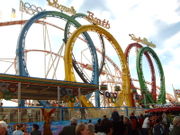
Freimarkt
Encyclopedia

Germany
Germany , officially the Federal Republic of Germany , is a federal parliamentary republic in Europe. The country consists of 16 states while the capital and largest city is Berlin. Germany covers an area of 357,021 km2 and has a largely temperate seasonal climate...
, first held in 1035, is the oldest fair
Fair
A fair or fayre is a gathering of people to display or trade produce or other goods, to parade or display animals and often to enjoy associated carnival or funfair entertainment. It is normally of the essence of a fair that it is temporary; some last only an afternoon while others may ten weeks. ...
in Germany. With more than four million visitors each year, it is also considered to be the biggest festival in Northern Germany.
It is celebrated for 17 days in the last two weeks of October, somewhat extended from Friday to Sunday. The area covers approximately 100,000 square meters on two areas: the so-called "Kleiner Freimarkt" (lit. Small Free Fair) on the market square, and the main area at the "Bürgerweide" adjacent to the Main Station and the Exhibition Center.
The highlight is the "Freimarktsumzug" (lit. Free Fair Procession) held on the second Saturday of the festival.
History
On 16 October 1035 Emperor Conrad II gave the "fair justice" to the city of Bremen. In the first centuries it was a free marketMarket
A market is one of many varieties of systems, institutions, procedures, social relations and infrastructures whereby parties engage in exchange. While parties may exchange goods and services by barter, most markets rely on sellers offering their goods or services in exchange for money from buyers...
for one day on 9 October. A showman with a carousel
Carousel
A carousel , or merry-go-round, is an amusement ride consisting of a rotating circular platform with seats for riders...
appeared for the first time in 1809.
Chronology
1035Emperor Conrad II grants the right to hold a fair to Archbishop Bezelin
1404
The Roland, the stone landmark of the city of Bremen, is erected.
1450/1489
The so-called ‚Kundigen Rullen' granted by the city, limited the Freimarkt for all time to the period when ‚de banere up den markede styet', i.e. the special flag was hoisted to display the agreed market peace
1793
Franz II is the last German Emperor who grants the Bremen merchants the right for the Freimarkt - as of this time, they decide themselves when they want to celebrate.
from 1800
With the Enlightenment, which freed life and customs of traditional formality, and the introduction of carousels and swings, the selling market transforms into an entertainment market.
1809
The first carousel turns on the Freimarkt - Operator: the restaurant owner, Wilhelm Pohlmann
from 1830
The Bremer Freimarkt develops into an attractive event far beyond the borders of Bremen. The city has to turn away market operators for the first time due to insufficient space.
from 1860
The market develops further on account of technology eg. illumination: 1862 oil lamps are replaced by petroleum lamps, these then by gas lamps as of 1880, and four years later by electric lamps.
The railway connects Vegesack, Bremerhaven, Oldenburg, Hanover and Hamburg.
1936
The Freimarkt, which had taken place at differing locations (Grünenkamp, Domshof, Hohenstorsplatz), gets a fixed location in the heart of Bremen: on the Bürgerweide.

